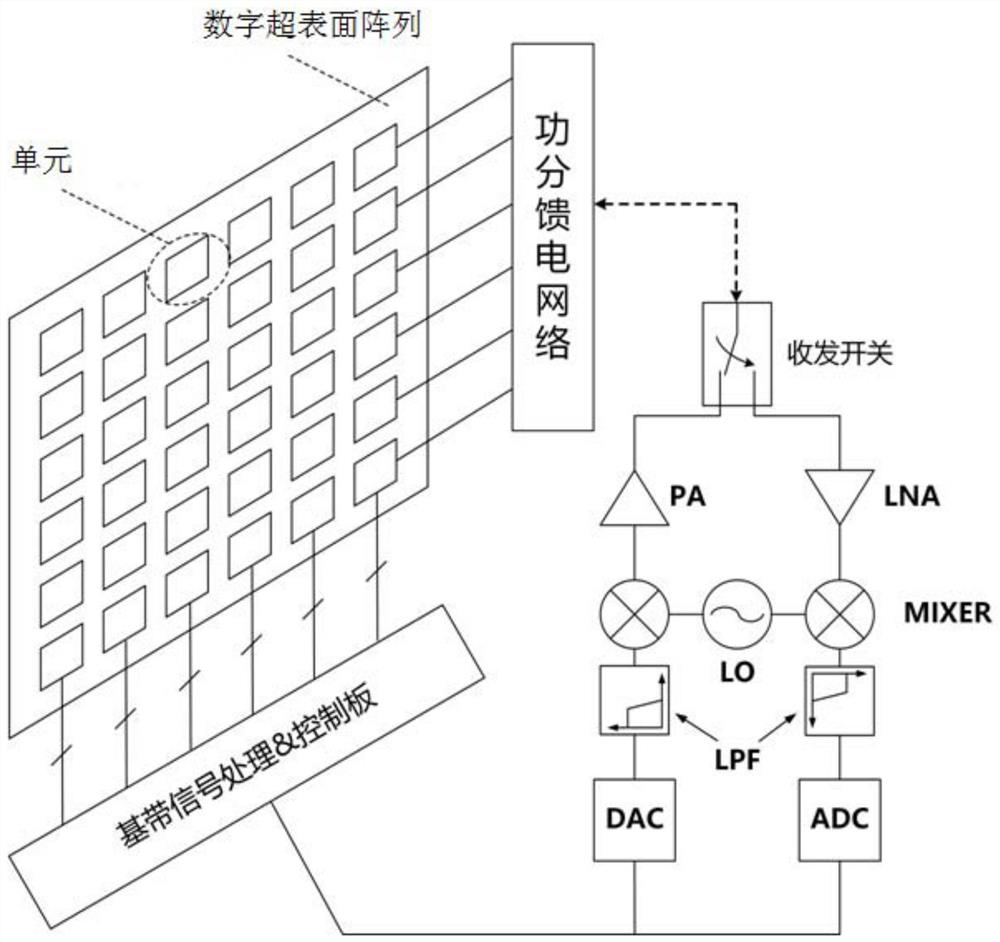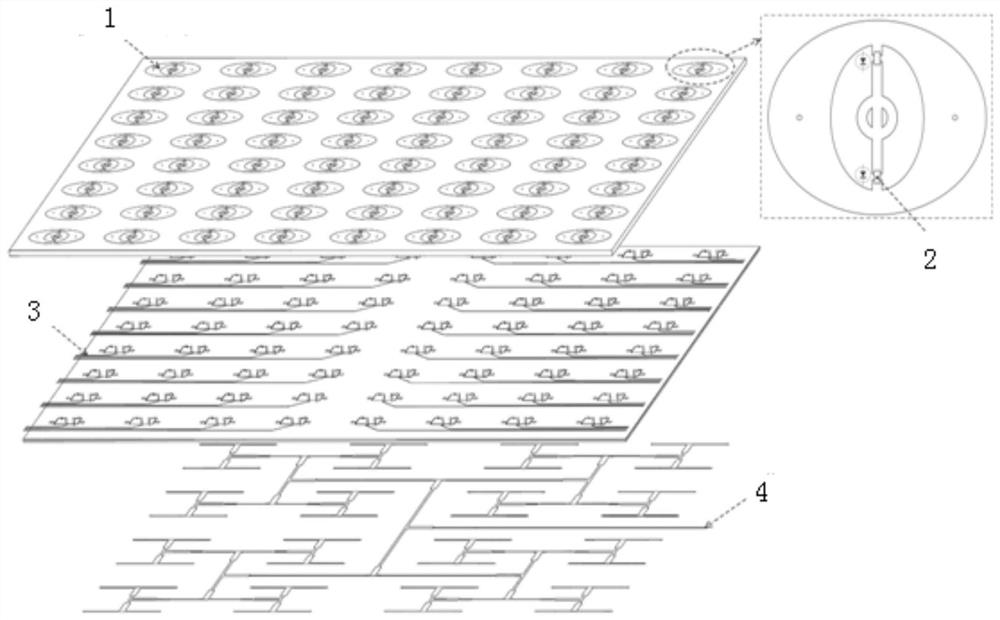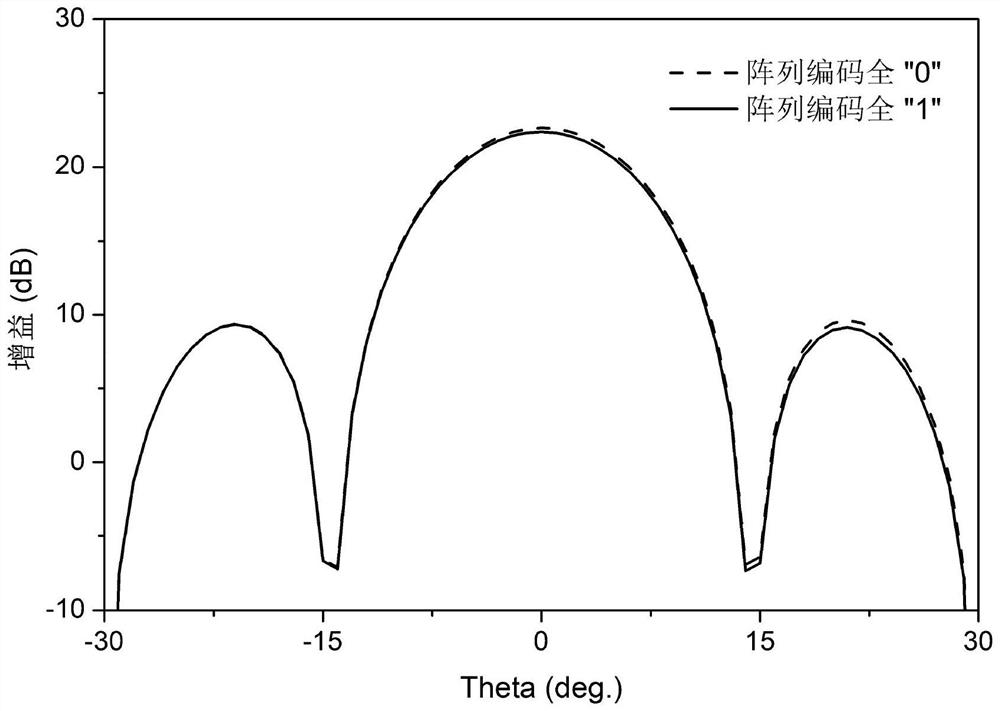DBF phased array system based on time modulation digital metasurface
A time-modulated, metasurface technology, applied in transmission systems, radio transmission systems, diversity/multi-antenna systems, etc., can solve the problem of insufficient degrees of freedom, and overcome the poor phase quantization accuracy, overall power consumption reduction, The effect of simplifying complexity
- Summary
- Abstract
- Description
- Claims
- Application Information
AI Technical Summary
Problems solved by technology
Method used
Image
Examples
Embodiment 1
[0059] Embodiment 1: one bit time modulation digital metasurface transceiver antenna array
[0060] Please also see Figure 2 to Figure 3a , 3b.
[0061] In this embodiment, we build a one-bit digital metasurface antenna array with 8×8 array elements. The central operating frequency of the antenna is 7.5GHz, the array element spacing is λ / 2, and the overall size of the array is 160mm×160mm×2.339mm. Feed through the microstrip power division network, the detailed structure of the array can be found in figure 2 .
[0062] The one-bit digital metasurface antenna array includes alternately arranged 4 layers of metal structure layers and 3 layers of dielectric layers, from top to bottom: metal radiation patch layer 1 integrated with PIN diodes, upper dielectric substrate, bias Control network layer 3, semi-cured dielectric bonding sheet, metal floor layer, lower dielectric substrate, and power distribution feed network layer 4. Among them, the top metal radiation patch is comp...
Embodiment 2
[0064] Embodiment 2: Precise orientation perception based on time-modulated digital metasurface
[0065] First, the rationale is given as follows:
[0066] Consider an N-element linear time modulation array with element spacing D. Suppose the carrier frequency is F c The unit signal is incident on the array from the θ direction. Taking the first unit as a reference, the digital metasurface unit is periodically modulated, and after space feeding and combining, the received radio frequency signal passes through a low-noise amplifier, a mixer and a low-pass filter successively. After down-conversion, it is sampled by an analog-to-digital converter. In the digital domain, the fundamental wave and the first N-1 harmonic components are estimated by discrete Fourier transform or fast Fourier transform to obtain harmonic eigenvectors. Then, the Fourier series expansion is carried out on the modulation timing of each unit of the digital metasurface, and the harmonic characteristic ...
Embodiment 3
[0069] Example 3: Beamforming based on time-modulated digital metasurfaces
[0070] Please also see Figure 4 to Figure 8 .
[0071]In order to realize the digital metasurface adaptive beamforming based on time modulation, it is first necessary to restore the signals received by each unit on the digital metasurface under the constraints of time modulation. Since there is only one signal after spatial feed synthesis, in order to realize the separation of received signals on the digital metasurface, it is necessary to use the harmonic components generated after periodic time modulation. The idea is as follows: the signal received by the digital metasurface is time-modulated Finally, it enters the receiving antenna through space feeding, and after low-noise amplification and down-conversion, it is converted to digital domain for analog-to-digital conversion. In the digital domain, the sampled signal passes through a group of band-pass filter banks, and the 2*Q+1 fundamental wav...
PUM
 Login to View More
Login to View More Abstract
Description
Claims
Application Information
 Login to View More
Login to View More - R&D
- Intellectual Property
- Life Sciences
- Materials
- Tech Scout
- Unparalleled Data Quality
- Higher Quality Content
- 60% Fewer Hallucinations
Browse by: Latest US Patents, China's latest patents, Technical Efficacy Thesaurus, Application Domain, Technology Topic, Popular Technical Reports.
© 2025 PatSnap. All rights reserved.Legal|Privacy policy|Modern Slavery Act Transparency Statement|Sitemap|About US| Contact US: help@patsnap.com



